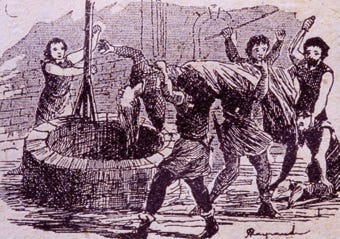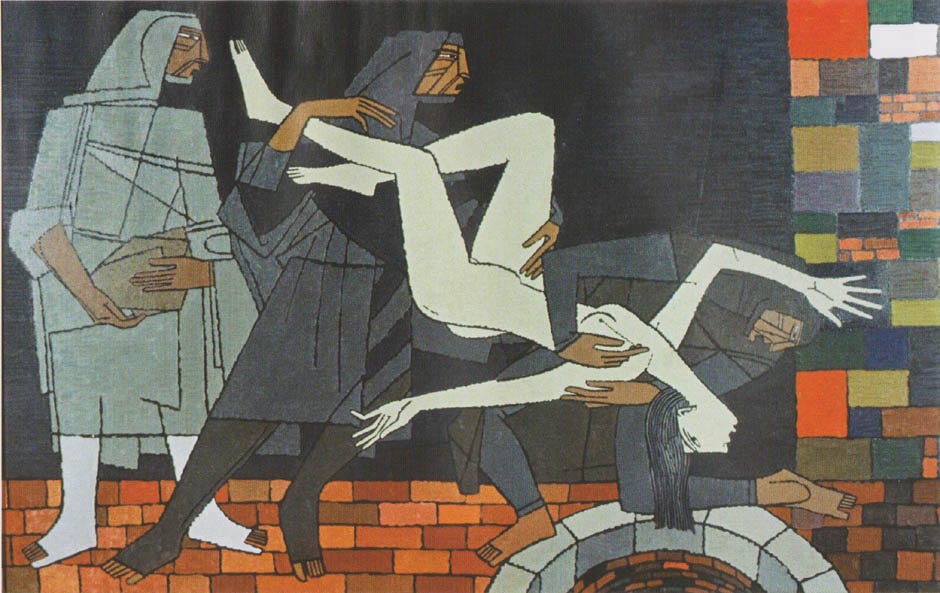June 25: the Day of Just Revenge
The “donas e tozas e molhers” of Toulouse aiming their catapult at the crusaders led by Simone de Montfort V. They hit him, and he fell on the ground, his head stained with dark blood. (image by Grok, refined by Flux).
You may think that revenge is not a good thing, and that it should be replaced by pardon according to Christian principles. Yet, in some cases, I would argue it is just and necessary, especially when it involves the revenge of the oppressed against the oppressors. One such case is the rape and murder of Guiraude de Lavaur on the part of Simone de Montfort V, during the Albigesian crusade in 1211. The crime was avenged on June 25, 1218, by a group of women of Toulouse. Hence, I propose to set this day in the calendar as “the day of just revenge”
Simone de Montfort V led the crusaders in one of the bloodiest exterminations in history, that of the Albigensians, known in our times as the “Cathars.” In 1211, he took the city of Lavaur, defended by Guirade de Lavaur (Guirauda de Laurac in Occitan). He had her raped multiple times by his soldiers and later he had her thrown into a well. Finally, just in case she was still alive down there, he had the well filled with stones. According to La Chanson de la Croisade Albigeoise:
« Estiers dama Girauda qu'an en un potz gitat,
De peiras la cubriron ; don fo dols e pecatz »
_____________
« And then Dame Giraude, they threw her into a well
They covered her with stones, which was pain and sin”
For Simone de Montfort, the day of reckoning came at the siege of Toulouse, June 25, 1218, when, according to La Chanson de la Croisade albigeoise:
Ac dins una peireira, que fe us carpenters,
Qu’es de Sent Cerni traita la peireira el solers
E tiravan las donas e tozas e molhers.
E venc tot dreit la peira lai on era mestiers
E feric si lo comte sobre l’elm, qu’es d’acers,
Que·ls olhs e las cervelas e·ls caichals estremiers
E·l front e las maichelas li partic a cartiers ;
E·l coms cazec en terra mortz e sagnen e niers
___________________________________________________
In a quarry, there were stonemasons,
Who were from Saint-Sernin, the quarry worked for the paving stones
And it was pulled by women and girls, and wives.
And the stone came straight there where it was needed
And struck the count on the helmet, which is of steel,
The eyes and brains, and extreme jaws
The forehead and cheeks were torn in quarters;
The count fell to the ground, dead and bleeding black blood
And so it was that donas e tozas e molhers took their revenge against Simon de Montfort, as he deserved. We can remember that day as the day of just revenge -
____________________________________________________________________________
We have no contemporary images of Guirade de Lavaur, this one is modern, and it represents the moment when she was thrown into the well
The image below, clearly inspired by Picasso’s “Guernica,” was painted by Jacques Fauché in 1960.
Fauché also painted this image in 2011
Here is a modern song about Dame Giraude.
Aujourd’hui je m’en vais, vous raconter l’histoire,
De la dame Guiraude, personne ne veut y croire...
Elle se passe dans le sud, ou pousse la cocagne,
Il y a fort longtemps, bien après Charlemagne.
Dans un joli village, où passait une rivière,
Il y avait un puits, orné de tresses en lières.
Les champs ensoleillés, verdissaient au printemps
Dame Guiraude aimait y passer bien du temps.
Vous l’avez deviné, ces gens étaient cathares.
Bien qu’ils furent heureux, s’inscrirent dans l’histoire,
De n’être comme ceux qui portaient une croix
Vêtus de rouge et blanc, vinrent en pays occitan.
Cette armée de croisés, armés de mille épées,
Vint pour les massacrer, tous jusqu’au dernier.
Et avec tant de haine, prirent la souveraine,
De pierres la lapidèrent, dans le puits la jetèrent.
Le lendemain matin, le paysage désolé,
Dans la neige empourprée, d’effroi se confondait.
Toujours dans nos mémoires, cette femme symbole,
C’est bien plus qu’une histoire, une légende folle...
I don’t know if this sculpture represents Simone de Montfort V, who fought in France in the Albigesian Crusade. More likely, it represents his son, Simone de Montfort VI. But we may imagine it is the Montfort who was known for his cruelty









